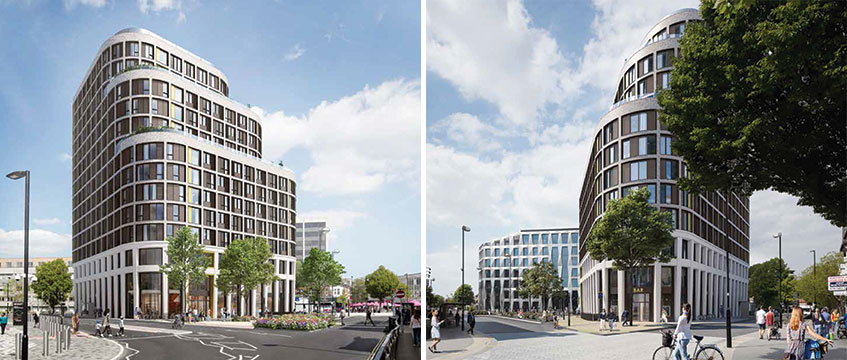London developer Galliard Homes is pursuing a debut co-living scheme in Hounslow, west London.
It has partnered with Princeton Investments to deliver a 248-bed scheme at its site on 1-3 Bath Road in Hounslow town centre (pictured).
The duo have worked up plans for a mixed-use development with 100,000 sq ft of co-living space designed by LOM architects and managed by operator Prima Vidae.
Galliard has submitted a planning application seeking to deliver co-living defined as “purpose-built shared living” under the sui generis use class, in a tower of up to 15 storeys.
Bath Road has shared kitchens on every floor, with basement, ground and first floor amenity space. A typical unit will measure 22.5 sq m, with the smallest rooms dropping to 20 sq m.
They will be available to rent with a minimum period of three months. The homes will target the under 35s professional market, offering “better-quality homes for flat sharers”. It will seek to replace the houses in multiple occupation tenancies that dominate this market.
The London developer is likely to face strong opposition from Hounslow Council, which has yet to approve any co-living and does not support homes that are smaller than the minimum space standards.
Hounslow Council leader Steve Curran told EG: “I am not convinced by the co-living model. It might work for a small minority of people for a short period of time. I am concerned that turnover will be high, and you could have issues around how people engage with the local community. What they are really are posh HMOs in another guise.”
Galliard’s planned shift to co-living supersedes previous discussions over residential development on the site, which was formerly home to a Yates pub.
It acquired the site for £2.3m in June 2016, under the subsidiary Stamford Hounslow. Construction company CJ O’Shea is also listed as a director with significant control of this company.
1-3 Bath Road is located on a triangle of land between Hounslow House civic centre and the high street in an area designated for high-rise residential development.
The scheme will also include 2,000 sq ft of co-working space from operator Work.Life, a games room, a TV room, quiet library space and a sun lounge.
Galliard will also look to develop a replacement pub to the south, a flexible commercial unit on the northern frontage of the site and 5,380 sq ft of public realm, which could also be used to host events.

Co-living lottery
Developers in London currently face a co-living planning lottery, depending on the particular borough’s support for this housing type.
The only developers to have received approval for co-living under the sui generis use class in London are The Collective (at its schemes in Ealing, Harrow and Wandsworth), Hallmark (in Ealing) and Get Living (in Lewisham).
The Collective has been forced to switch to hotel use after facing opposition from some councils and the Greater London Authority, which has been reluctant to set a standard for co-living room sizes.
When it first launched at Old Oak near Willesden Junction, NW10, The Collective offered rooms as small as 8.5 sq m. The smallest rooms at its forthcoming development at Trewint Street in Earlsfield, SW18, are almost double the size.
Last month, after a two-year wait for GLA approval, the developer ditched its co-living plans for 222 units at Stratford High Street, switching to a hotel. Rainbow Properties also tried and failed to achieve planning consent for co-living in Hackney.
Other co-living launches have come via permitted development prior approvals for conversions, bypassing local authority planning teams, as seen from Mason & Fifth and Dandi Living, which specialises in “affordable luxury living” micro-homes.
To send feedback, e-mail emma.rosser@egi.co.uk or tweet @EmmaARosser or @estatesgazette











